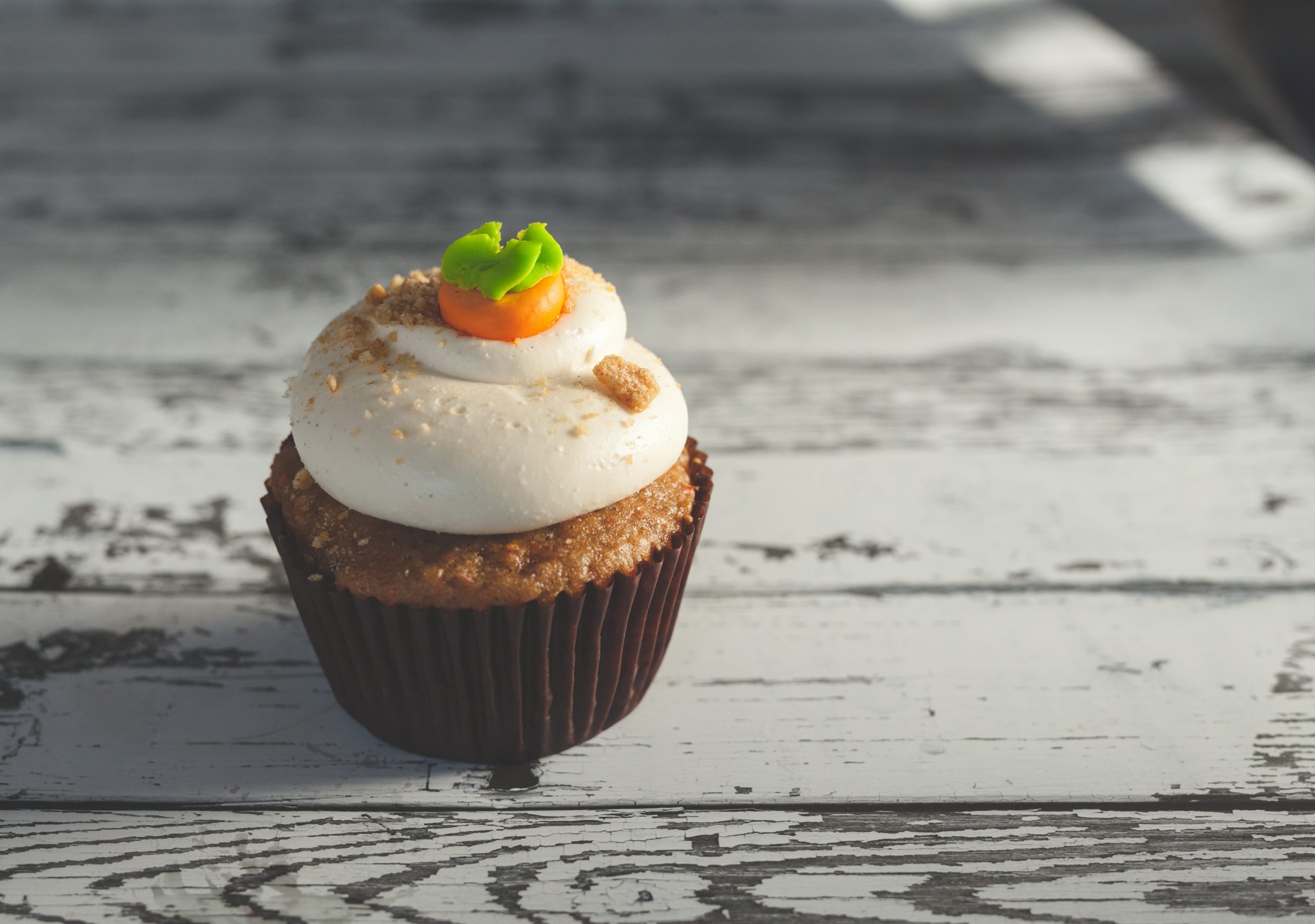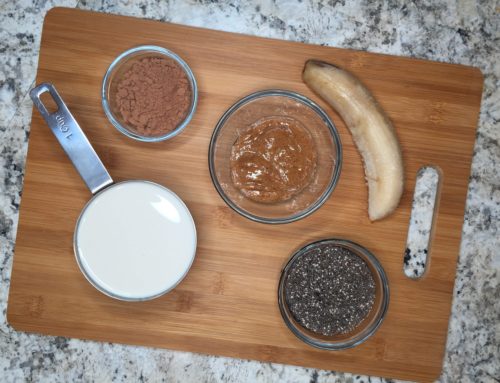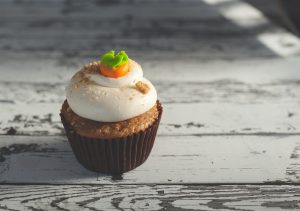
Does this cupcake use natural sugars or artificial sweeteners?
What is “sugar”? A sweet-tasting, soluble carbohydrate. Simple as that.
Anatomy:
The tongue is the first place for taste to occur, with four different types of taste buds. Each taste bud can taste “edible” versus “noxious”, as well as a defined/special variety of flavors, type 2 being for sweet foods. These receptors belong to a family of proteins called G-Protein coupled receptors. T1R2 and T1R3 are the specific G Proteins that detect sweet, and thus, trigger a cascade of bodily responses for the incoming sugar. Of these bodily responses is the release of hormones that help process sugars, including glucagon-like peptide 1 (GLP-1). This hormone is responsible for encouraging the body to absorb glucose from the bloodstream, enhancing insulin release from the pancreas, and regulating appetite. It is this process that becomes dis-balanced or disturbed in type 1 and type 2 diabetes.
Questions to Consider:
With these biological processes in mind, the list of questions to consider when selecting healthy sugars is as follows:
 Does the body recognize it as a sugar?
Does the body recognize it as a sugar?- Can the body use it for energy? And if so, how much energy does it take to use this sugar, versus energy earned from this sugar?
- Compromise blood glucose levels?
- Trigger insulin and blood sugar glucose?
- Caloric intake of the sugar molecule match dietary needs?
- Stored, and if so, can it be easily accessed?
- Contain other toxic ingredients?
Chemicals & Toxins
The very first step recommended in altering your sugar intake is to immediately stop any chemically processed sugars. This includes Sweet N Low, Splenda, and Asparatame. These are neurotoxins that cause a multitude of conditions, trigger insulin release without having a way to use it and build up toxicity levels in the body. Many products that claim to be sugar free or diet contain these and are far worse for you than using a simple sugar.
Sweeteners
Natural Sweeteners are best if you are looking to cut back on sugar because you are diabetic, pre-diabetic, pregnant, or predisposed t
o diabetes, including high blood glucose levels or poor insulin performance. Find sweeteners that do not spike blood glucose levels, but also that do not trigger an insulin release. These include Stevia, Monk Fruit, and Mangostene. Of all sweeteners, these are my highest recommendation.
Stevia
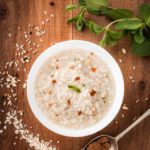
Sweetleaf ® is a wonderful brand, that makes both a liquid dropper for sweetening items like coffee and iced tea, but also a water enhancer that is free of chemicals, dyes, and sugars. You can also find some wonderful products by Zevia ®, including sodas and energy drinks that are sweetened with stevia (also free from artificial dyes!). You can buy Stevia in a powdered form in the baking aisle as well, but it is often mixed with another sugar. Be cautious of the extra ingredients when buying powdered stevia, or stevia granules.
Stevia is a strong flavor. For liquid drops of sweetener, I recommend starting with just 3 or 4 drops in a cup of coffee or iced tea, and slowly adding to your liking. A little bit goes a long way here. I also only use ½ of a Stevia packet of sweetener, compared to a full packet when I use cane sugar. You can also bake with Stevia, just make sure to follow the substitution guidelines on the packaging.
Monk Fruit & Mangostene
Plant based sweeteners Monk Fruit and Mangostene are also available in powder and liquid, are a bit stronger than stevia. They are a bit more rigid in their selection, and a bit more difficult to come by. You will often-times find Monk Fruit mixed with other sweeteners.
All three of these options are potentially safe for diabetics, pregnant women, breastfeeding, and anyone trying to manage weight, detox, or avoid toxins in general. However, these options are sweeteners only and will not lead to energy production. These are not recommended as energy sources for pre or post workouts but are great ways to sweeten pre and post workout options that contain other sources of energy.
Natural Sugars
Other naturally occurring sugars are going to depend on the chemical make up of their molecules. While fruit is a naturally occurring sugar, it is fructose- two glucose molecules stuck together. This means that the body can break down the sugars, but it does take a bit of energy. It also means it will spike blood glucose levels, trigger insulin release, and give you energy. This also means, that too much of a good thing (i.e. fruit) will end up stored in fat cells if you over consume. Limit your fruit to 2-3 servings per day, or pair it with a protein to help better utilize the fructose.
Natural sweetening options like date paste and unsweetened apple sauces are great recipe replacements for sugar. They preserve your body’s ability to break down, utilize, and process sugars, without filling yourself with toxic chemicals. Note that these options are typically a bit higher in calories, and to use extra caution if you are counting your calories and macro-nutrients.
Glucose
The simplest form of sugar, glucose, breaks down the fastest for the fastest use. It also yields the most dramatic blood sugar spike, and therefore will lead to insulin resistance when abused, as well as other hormonal imbalances. In moderation, glucose is a great source of rapid energy. The body does best when paired with protein to help minimize the “crash” of the glucose leaving the blood for energy production. Extra glucose is also stored in fat cells. A word of caution- it is easier to get energy from new glucose sources than it is to remove it from the cells. Which means typically when it’s put there, if you keep feeding your body sugar, it will stay there. This is also why many “
diet” plans recommend removing all sugars, including fruit, for weight loss.
A Compromise
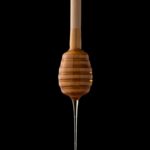 Honey is a naturally occurring sweetener that is both glucose and fructose. This means you will get readily available energy, plus some sustained energy, and less of a spike in the blood sugar than you would with table sugar. Honey is a great in between and is wonderful for pre and post workout energy. It is potentially safe for pregnant, breastfeeding, and weight loss. Honey is also great for allergies, skin health, and boosting your immune system. Please note that children under the age of 1 should not consume honey as they are more likely to response to any micro-bacteria that may exist in the honey than an individual with a developed immune system. Honey will store in fat cells when it is over-consumed.
Honey is a naturally occurring sweetener that is both glucose and fructose. This means you will get readily available energy, plus some sustained energy, and less of a spike in the blood sugar than you would with table sugar. Honey is a great in between and is wonderful for pre and post workout energy. It is potentially safe for pregnant, breastfeeding, and weight loss. Honey is also great for allergies, skin health, and boosting your immune system. Please note that children under the age of 1 should not consume honey as they are more likely to response to any micro-bacteria that may exist in the honey than an individual with a developed immune system. Honey will store in fat cells when it is over-consumed.
Concerning Options to Avoid
When a glucose molecule (simply broken down) and a fructose molecule (two glucose together) are combined, you have sucrose. Sucrose is a lot more difficult to break down, but because it contains glucose and fructose, it spikes blood sugar levels more than our fructose friends (honey and fruit). These include sugar, brown sugar (light and dark), bananas, maple syrup, and molasses (30% sucrose, 12% fructose). Consume with just as much caution as you would regular sugar, but consider these as alternatives. Furthermore, they lead to blood sugar spikes that are more dramatic than the value they give us for energy.
When multiple fructose molecules become stuck together by chemical nature, you are given high fructose. For example, high fructose corn syrup, corn syrup, and agave nectar. These sugars are sweet in nature but take a TON of energy to break down into energy, and therefore are often pushed aside by the body in a “it’s not worth it” fashion. They are your worst enemy for weight loss, and equally detrimental to cleanses and detoxing. I recommend avoiding these three sweeteners to all individuals.
Other Considerations
So, when you know which category of sweetener you are aiming for, then you can figure out which foods to avoid, right? It’s unfortunately not that simple. The FDA has a lot of loopholes in their nutritional requirements, and the commercial food industry is aware of it. We do have a few things going for us though. 2020 nutrition labels now define “per container” on any package that could be consumed in one sitting. This is key for sodas and juices. They also must now disclose added sugars versus naturally occurring sugars. Example: Orange juice is now labeled by natural sugars from the oranges, and added sugars. This is crucial when evaluating “sugar free” and “low sugar” options.
Labels & Requirements
Use additional caution on sweetening ingredients that seem harmless, such as brown rice syrup, barley malt, Yacon Syrup, and Birch Syrup. These are all added sugars as well and are listed separately in the ingredients list than sugar. Which means, even if sugar isn’t the first/primary ingredient, in total it could very well make up the majority of the product.
Summarized Recommendations
Altering your daily nutrition to combat diabetes and other insulin/glucose related illnesses is key to reaching a healthy lifestyle. It will, however, look different for everyone. Start by reading your labels and identifying where and how much sugar you are consuming daily. Then identify small but simple ways that will add up to big changes, such as gradually lowering added sugars. When you become confident with one transition, start another. These small choices will add up over time, creating a cascade of health for you, and ultimately leading to a stronger version of yourself.
If you are struggling with sugar cravings, consider checking out our glucose balancing products through our online dispensary at us.fullscript.com/welcome/prospectivelyhealthy.
Just Ask!
If you would like help with recipe modifications, identifying sugar sources, and altering your choices, reach out to us on social media, or via our Contact Us Form. We look forward to working with you.
Stay Healthy, Stay Happy.
References:
Marieb, Elaine Nicpon,Hoehn, Katja.Human Anatomy & Physiology. Boston : Pearson, 2012. Print.
Mateljan, G. (2007). The World’s Healthiest Foods. Seattle: George Mateljan Foundation.
Agriculture Research Services. (2017, October). USDA Food Composition Database. Retrieved from USDA: Agriculture, U. S. (2015). USDA Food Patterns. Retrieved from USDA:
United States Department of Agriculture. Retrieved from Center for Nutrition Policy and Promotion: Department of Chemistry and BioPhysics. (2003, September).
Essential Amino Acids. Retrieved from The Biology Project: Food & Drug Administration. (2017, April).
Code of Federal Regulations. Retrieved from US Food & Drug Administration: Harvard Medical School. (2009, June).
Listing of Vitamins. Retrieved from Harvard Health Publicating: National Academies Press. (2004, February 11).
Dietary Reference Intakes: Water, Potassium, Sodium, Chloride, and Sulfate. National Institutes of Health. (2013, June). VItamin & Mineral Supplements Fact Sheets. Retrieved from National Institute of Health


